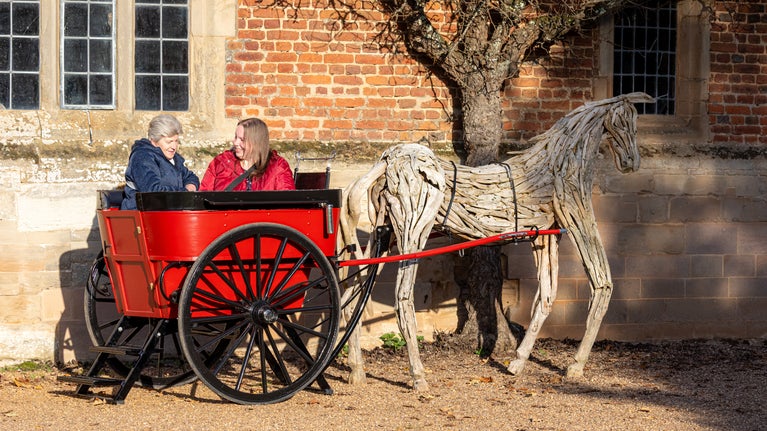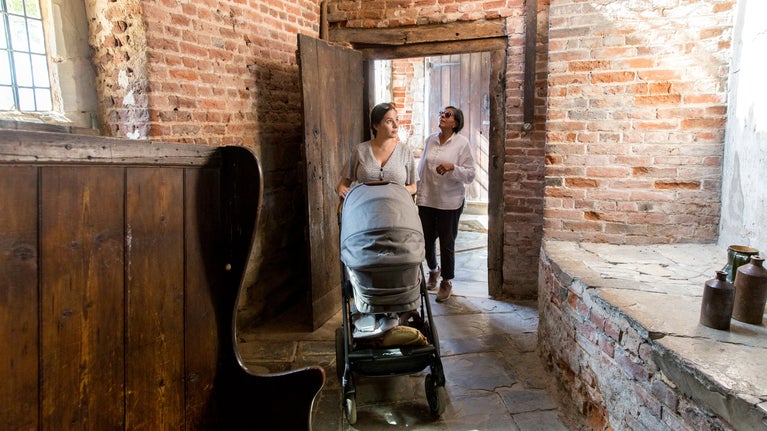Things to see and do in the Service Courtyard

Charlecote Park has one of the best original carriage collections in the National Trust's care and a rare surviving brewhouse, amongst other hidden treasures.
Immaculately preserved outbuildings
Charlecote Park is not only a grand Tudor house where the Lucy family lived, it used to be a home and workplace for countless servants who cleaned, cooked, laundered, brewed beer and took care of horses in what is now known as the Service Courtyard. The exceptionally well-preserved brewhouse, laundry, kitchen, scullery, carriage houses and tack room are well worth a visit. These rooms are open every day from 10:30am on a free-flow basis.
The Working Spaces
The Laundry
The laundry stands in a building that was once a bakehouse. Later, it was used as a two-storey laundry; downstairs was the ‘wet laundry’ for washing the linens; upstairs (no longer accessible) was used for drying and ironing linens.
The Brewhouse
Just behind the Laundry stands the Brewhouse, a rare survival that is worth a visit. Many British households used to brew their own beer for home consumption.
Barley was grown here on the Charlecote estate and converted into malt in the local village, before being brewed in the Brewhouse. The barrels were then stored in the cellars underneath Charlecote House.
The Slaughterhouse
Recently reopened, the Slaughterhouse, situated in the Wood Yard, is where the game was butchered.

The Stables and carriages
The Carriage Houses
The three Carriage Houses contain one of the best original carriage collections in the National Trust's care. Here you can compare the merits of a phaeton, a wagonette or a brougham, or spot a funeral bier or breaking cart amongst the dozens of carriages and coaches. The barouche on display is one of the best survivors of this style in Britain – it’s the one that is ‘saucer-shaped’ and had spikes at the rear to deter anyone from hanging onto the carriage.
The Tack Room
The Tack Room, with its saddles, bridles, and other horse equipment, was also the office of the Head Groom. Still actively used up until the 1970s by the Lucy family, the tack room is now open to the public year-round. You can spot the name plates of long-gone horses, such as ‘Limelight’.
Stables Second-hand Bookshop
As you explore the Service Courtyard, don't forget to pop into the second-hand bookshop, located in one of the old stable blocks. The books are carefully stacked up around some of the original fixtures and fittings still in place. There are still the original wooden grain shoots.
The Victorian Kitchen and Scullery
The Victorian Kitchen
The kitchen at Charlecote is one of the best surviving Victorian kitchens in Britain and would once have been the bustling hub of the house.
Its impressive ceiling height helped disperse the heat generated by cooking. There’s also ample space in the large dresser to store dozens of tureens, moulds, dishes, pots and pans.
While the kitchen is Victorian, its floor is Tudor – the flagstones once graced the original Great Hall of the house before its refurbishment in the 1840s.
Today, the kitchen is preserved in time, with the fireplace and historic working table taking centre stage. You can imagine this space being a hive of activity to feed the estate.
The Scullery
Adjoining the kitchen, the scullery was used for washing huge amounts of vegetables and crockery with well-water. The walls were painted powder blue as this was thought to repel houseflies. Peer inside the original bread oven as you walk through this space. Bread was made using the flour stored in the large flour bin.
The Servants’ Corridor and Servants’ Hall
The kitchen leads into the Servants' Hall shop. As you step through the corridor, look up at the row of bells near the ceiling. The Servants' Hall would have been a bustling space for the service staff to congregate. Take a look at one of the walls to see what their average yearly wage would have been!